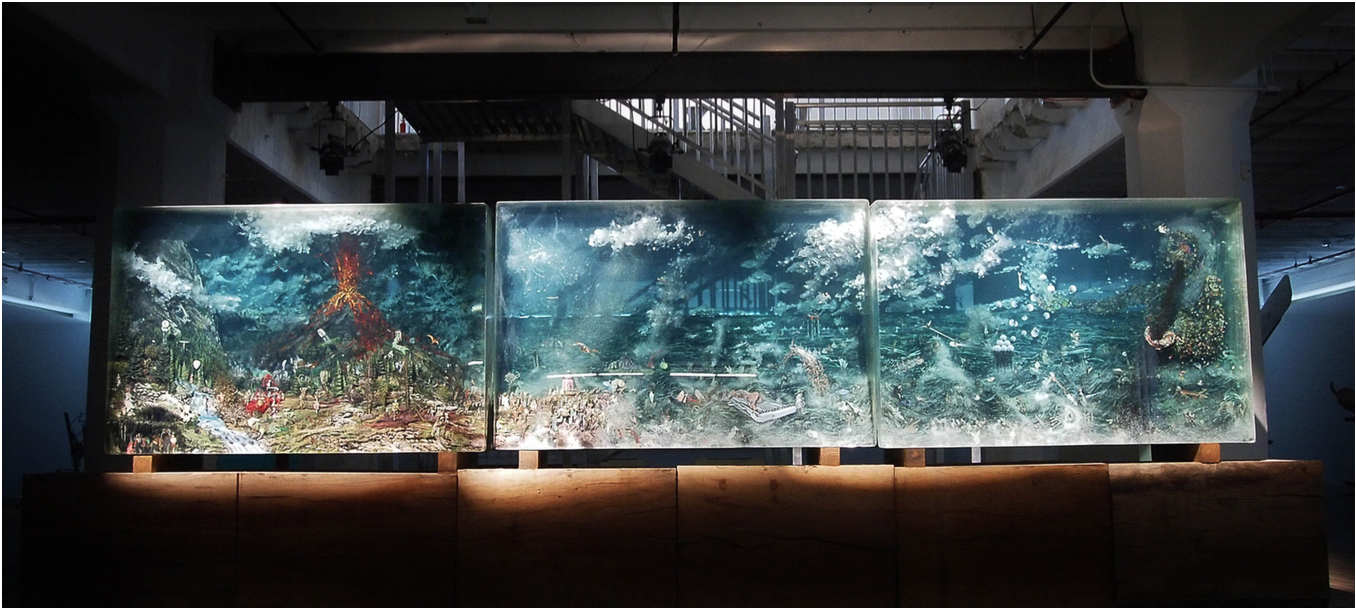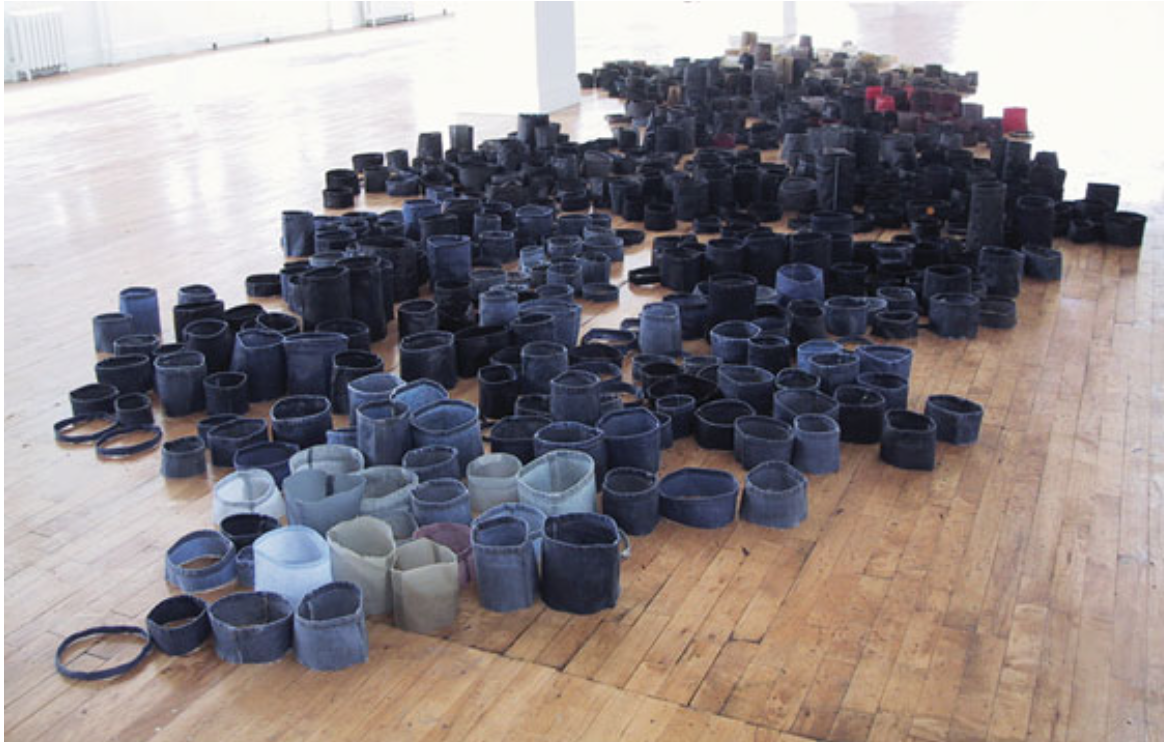

(Fig.1) Triptych, by Dustin Yellin, Retrieved from http://beautifulnow.is/bnow/soul-under-glass- now
Véronique Chassé
1st year, Art Education major
Material Culture: Concepts of Material Culture Studies and Collecting in Community Art Practice
According to the Webster’ New World Dictionary, to collect is “to gather together and assemble” (Agnes, 1999, p.287). In other words, accumulating things we encounter either by chance or through research and bringing them together somehow. We could see the act of collecting as mimicking the way artists use physical and intangible materials from their environment to construct original creations. As artists go about their lives–seeing, hearing, smelling, tasting, touching, doing and feeling things–they are gathering material. “There is a dialectical, recursive interaction among persons and things that influences how we think, act and construct our sense of self ” (Graham, 2011, p.64). In considering the art practice in this way, community art participants, regardless of their background or experience, are well-equipped collectors and artists. Whether we are conscious of it or not, none of our decisions are random. We can observe the way artists gather and select the materials they use and how they choose to assemble them in meaningful creative ways. In a community art education setting, anyone can find ways to play with their collections through art making as long as they have a nurturing and open art space. Through the constant stream of experiences we all have, artists build their collection by acquiring information about the materials in their environment. What artists choose to register in their visual vocabulary will differ just as collections will vary between collectors. The material an artist or a collector selects depends on what they deem to be interesting, unique and precious. Anything can be collected just as anything can be an inspiration, subject or medium in art making. We could also say that every material used in art making comes from the environment of the artist. Artists are always referencing materials they have been exposed to in some way. They might not always be immediately conscious of their choices but in questioning their decisions, they might “discover and reveal the culture in which they live (…) [and] reveal themselves as cultural beings, participants, and embodiments of culture” (Marshall, 2002, p.282). Our understanding of any given material is the result of its relationship with other materials and ourselves. We find certain things more interesting than others and choose to focus our attention on them. Why does a seashell collector decide to keep seashells and not pebbles? Why does a landscape painter choose to illustrate landscapes rather than people? We choose to focus on certain materials rather than others not because of their inherent value but because of values we discover in them through work, play, or other kinds of relations we make with them.
In his Ted talk, A Journey Through the Mind of an Artist, Dustin Yellin describes his use of boxes for creating relationships and stories between everyday found objects (Yellin, 2014). Yellin creates intricate three-dimensional works in which he combines all sorts of objects, symbols and images (Fig.1). Each element conveys a meaning because of its relationship to other elements. His work could be seen as collections of cultural references, which borrow material from the fields of politics, science, mythology, ecology, and so on.
In constructing works of art or collections, we attempt to bring order and communicate the relationships between collected materials, although what we create will consequently vary tremendously due to our own set of references and experiences (Graham, 2011, p.64). Artists make sense of their gathered material by integrating them in ways that are meaningful to them. Once an artist has accumulated material they must sort through it, understand what they are working with, figure out how they relate to each other and interpret them. It is by assembling things that artists develop their creativity and explore meta-statements. For example, Jean Shin’s installation, Alterations (Fig.2) combines scraps of shortened pants, a material that holds little value in and of itself, in a way that addresses several bigger issues. The way she chose to assemble her material is significant in communicating her message. In positioning the pant scraps upright and side-by-side, she created a cityscape which references members of the population. The variation in height is also symbolic of the diversity of height in the particular Chinese population responsible for many of the fashion industry’s manufacturing (Shin, 1999). While Shin reflected on the minor details and interpretations of her piece, other artists might not consciously aim to convey such complex messages. In a community teaching environment, participants might not question their choices every step of the way.
However, the way they decide to construct their work holds a wealth of meaning and information that can be investigated further. None of their decisions are truly random. Instead, open-ended forms of engagement with the various materials that move us can lead to great discovery. Art works and collections “can be a way to order or come to terms with the strangeness, complexities, and randomness of the world” (Graham, 2011, p.67). They give new meaning and identity to the materials being used; the physical material as well as the intangible, conceptual or symbolic material.
Finally, by drawing parallels between the act of collecting and art making, we might begin to acknowledge and welcome diverse ways of art making and of being an artist. In order to be considered an artist, one does not necessarily need to produce a wealth of works or to consciously research material or to construct things that are intended as art works. What if we extend the definition, borrowing from the artist’s and the collector’s capacity to pay careful attention to materials?
Art making, then, engages us all in our everyday lives whether we are aware of it or not. “A picture, a book, a piece of music, can remind [us] of feelings, thinkings, [we] did not even know [we] had forgot. (…) The process of art is a series of jolts, or perhaps (…) volts, for art is an extraordinary faithful transmitter” (Winterson, 1995, p.13). By studying material culture, we are focusing on « the physical, material nature of objects and the human practices that surround them » (Graham, 2011, p.64). Everyone’s relationship with their environment, culture, history is unique, but what we all have in common is a relationship of some sort to material culture. We are constantly gathering and assembling materials. In community art practices, taking a collector’s approach to art making, and allowing a playful interaction with their gathered materials, might help empower participants and make art making a more accessible practice.

(Fig. 2) Alterations, by Jean Shin. Retrieved from http://jeanshin.com/alterations.htm#
References :
Graham, M.A. (2011). The Art of Collecting, Material Culture, and Place-Based Education. In D. Blandy & P. Bolin (Eds.) Matter Matters : Material Culture and Art Education. (pp.63-73) Reston VA : National Art Education Association.
Marshall, J. (2002). Exploring Culture and Identity Through Artifacts : Three Lessons Derived from Contemporary Art Practice. In Y. Gaudelius & P. Speirs (Eds.). Contemporary Issues in Art Education. Upper Saddle River, NJ : Prentice Hall
Shin, J. (1999). Alterations. Jean Shin [website]. Retrieved from http://jeanshin.com/alterations.htm
Agnes, M. (1999). Webster’s New World College Dictionary. (p.287). Macmillan USA.
Winterson, J. (1995). Art Objects :Essays on Ecstasy and Effrontery. New York : Vintage Books, pp.3-21.
Yellin, D. (October 2014). Dustin Yellin : A Journey Through the Mind of an Artist. Ted : Ideas Worth Spreading. https://www.ted.com/talks/dustin_yellin_a_journey_through_the_mind_of_an_artist#t-250300